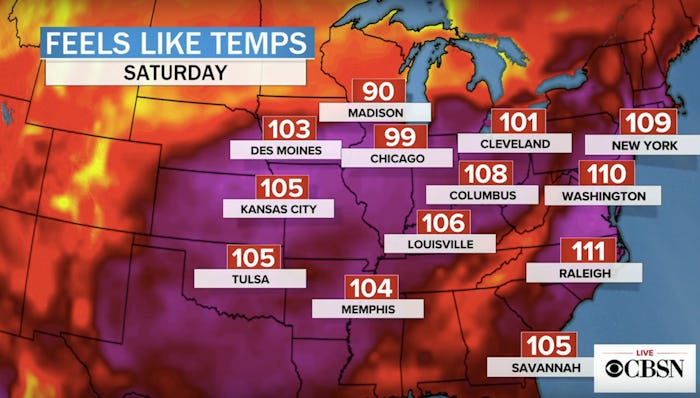News
This Map Details Where The Upcoming Heat Wave & "Extreme" Weather Is Expected To Hit
In case you haven't heard, a heatwave is nigh. It's set to blaze through most of the country throughout the weekend, and it's crucial to plan accordingly. Though often less obvious, heat can be just as dangerous as cold weather, which is why this map of the 2019 heat wave will help you see what temperatures your area could potentially reach.
Created by the National Weather Service (NWS) there are actually multiple maps, organized by day. Maps are available from Sunday, July 21 to Thursday, July 25, though temperatures may spike before that. To access the maps, you can visit the NWS site, on which you can select a map for the day you would like to know about. On the lefthand column, you will see the maps that are categorized in the maximum heat index. This means that these are the maps showing what areas will be impacted by temperatures potentially reaching either 95, 100, 105, 110 or 115 degrees. You can view information for a specific city or area by clicking on the map.
On the NWS site, you can also view maps for the minimum heat index, meaning the areas of the country that will be experiencing lows, which are unfortunately ranging from a minimum of 75 degrees at this point. Either way, this is your most comprehensive source for gathering information about exactly what to expect in the coming days.
According to the International Business Times, the heat will be spread throughout the country, however, Kansas, Nebraska, Iowa, Missouri, Oklahoma and Illinois in particular are being advised for "extreme heat warnings," as well as the "hottest temperatures so far this year" to states like New York City, Chicago, Detroit, and Washington, D.C.
Extreme temperatures can actually be very dangerous for your health. National Weather Service explains that during extremely hot and humid weather, your body's ability to cool itself is "challenged," and when the body heats rapidly, temperature rises, and fluid and salt is lost, potentially resulting in dehydration.
This can result in discomfort, and be particularly dangerous for those who already have preexisting conditions. However, you should also be aware of are heat-induced illnesses, which are heat stroke, heat exhaustion, heat cramps, sunburn and heat rash. According to the U.S. Centers for Disease Control and Prevention (CDC), the warning signs for most of these typically encompass a highly elevated body temperature, rapid sweating, light headedness, becoming pale, headache, dizziness, nausea, confusion or passing out.
However, the CDC also recommends that all people take the following precautions to ensure their heat risks remains at a minimum. First, the CDC recommends that you drink enough water throughout the day, stay in shaded or air conditioned spaces if possible, avoid direct sunlight or activity around mid-day, when the temperature peaks, pace yourself, wear loose, cool clothing, and take cool showers or baths to cool down.
Preparing for a heat wave needs to be approached with as much care as one prepares for bitter cold temperatures as well, as either extreme can certainly pose a health risk to anyone exposed for extended periods of time. Ensure that you and your family are prepared by stocking cool beverages, and checking in on friends and relatives throughout the week.
